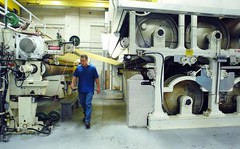
PREV ARTICLE
NEXT ARTICLE
FULL ISSUE
PREV FULL ISSUE
CRANE PAPER COMPANY LOOKS BEYOND U.S. FOR PROFITS
So who would be the big losers if the U.S. government stopped printing paper dollars? Crane & Co. is one - the firm has made the paper for U.S. currency for over 100 years. This article from The Boston Globe describes how the firm has been gradually expanding beyond the U.S. market.
-Editor
For Crane & Co. in Dalton, which produces the specialized paper for printing greenbacks, fewer bills means cuts in orders and revenue. So the company has added more governments to its customer list, including emerging economies where cash is still king and attempts to reduce counterfeiting are on the rise. The Crane family has been making paper for US currency for more than a century - through depressions, booms, and recessions. But in 2003, the Federal Reserve System updated the technology used to screen the condition of paper currency, effectively reducing the number of bills destroyed each year. (In 1989, 46 percent of $1 bills were destroyed; in 2010, just 21 percent were.) Over the past 20 years, the average life span of paper bills - $1s, $5s, $10s, $20s - has doubled. Longer lasting bills means the government has been printing fewer of them, according to the Fed. That means most of Crane's business now comes from overseas. "Selling to central banks throughout the world - that's a growing business for us for sure,'' said Charles Kittredge, the sixth-generation of his family to run Crane. "We are constantly looking for opportunities internationally.'' From its plant just outside of Stockholm, Crane produces paper for the currencies of Mexico, Thailand, India, and Egypt. For Tanzania, Sweden, and Chile, it both supplies the paper and prints the bills. It also produces enhanced security features - including specialized watermarks, fibers, and fluorescent elements - that are embedded in bills. South Korea, Costa Rica, and Lebanon buy such products from Crane. Between 20 percent and 35 percent of the company's revenue comes from paper for US currency, down from about 50 percent in 2001, Kittredge said. He declined to reveal Crane's revenue figures. Additional forays into paper products, such as filters to purify water and reduce air contaminants, are replacing the company's once-strong position in stationery, Kittredge said. The company also makes security papers for US and Swedish passports. Kittredge maintained that Crane will remain a company rooted in US currency. "The fun thing for me is to stand up in front of an audience anywhere in the country and be able to say that Crane & Co. products are in 98 percent of their pockets,'' he said. "We're ubiquitous.''
To read the complete article, see:
Still making money
(www.boston.com/business/articles/2011/07/09/the_money_maker_goes_global/)
The Numismatic Bibliomania Society is a non-profit organization promoting numismatic literature. See our web site at coinbooks.org. To submit items for publication in The E-Sylum, write to the Editor at this address: whomren@gmail.com To subscribe go to: https://my.binhost.com/lists/listinfo/esylum All Rights Reserved. NBS Home Page Contact the NBS webmaster 
|
